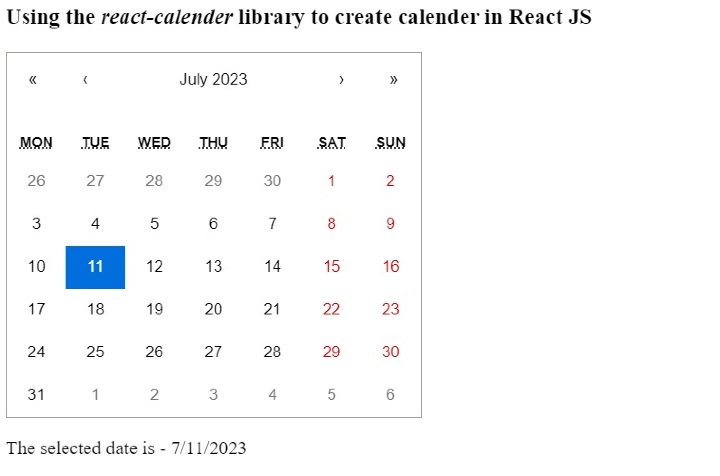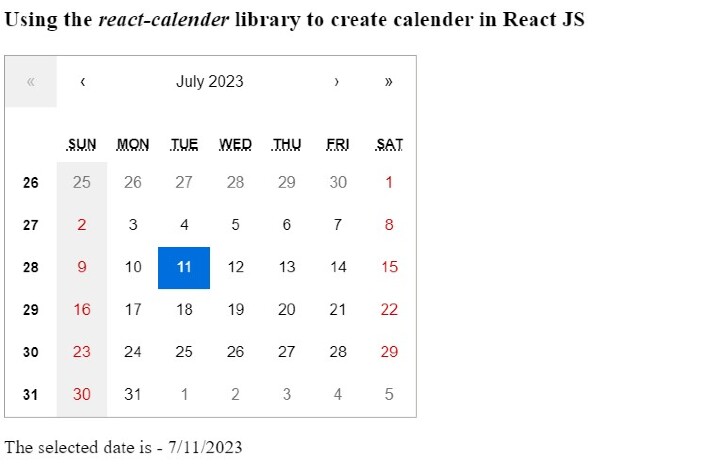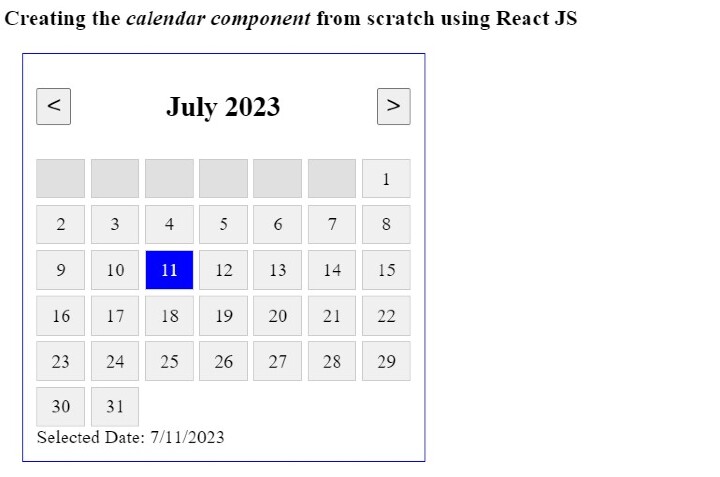如何在 ReactJS 中建立日曆?
在一些 Web 應用程式中,我們要求使用者輸入日期。例如,我們需要獲取使用者的出生日期或任何其他特定日期作為輸入。在這種情況下,最好向使用者顯示日曆並讓他們選擇日期,而不是將日期輸入作為字串,因為使用者在輸入字串時可能會出錯。
在本教程中,我們將學習如何使用內建的 React JS 庫新增日曆元件,或者從頭開始建立日曆元件。
使用 React-calendar 庫在 ReactJS 中建立日曆
“react-calendar” 是一個內建的 React 庫,允許我們在 ReactJS 中嵌入日曆元件。此外,它接受 props 以根據我們的需求自定義日曆。
程式設計師可以在終端中執行以下命令,以在專案目錄中安裝“react-calendar”。
npm i react-calendar
語法
使用者可以按照以下語法使用“react-calendar”庫的日曆元件。
<Calendar value = {date} />
在以上語法中,我們將“date”變數的值作為 prop 傳遞以顯示所選日期。但是,我們還可以傳遞“react-calendar”庫文件中提供的其他 props。
示例
在下面的示例中,我們從“react-calendar”庫中匯入了“Calendar”元件。之後,我們定義了一個名為“date”的狀態變數來儲存所選日期。此外,我們使用“calendar”元件顯示日曆,並將“date”和“changeValue”函式作為 prop 傳遞。“changeValue”函式用於更改所選日期的值。
在輸出中,使用者可以選擇日期、月份、年份等。
import React, { useState } from "react";
import Calendar from "react-calendar";
import "react-calendar/dist/Calendar.css";
function App() {
const [date, changeDate] = useState(new Date());
function changeValue(val) {
changeDate(val);
}
return (
<div>
<h3>
{" "} Using the <i> react-calender </i> library to create calender in React JS{" "}
</h3>
<Calendar onChange = {changeValue} value = {date} />
<p>The selected date is - {date.toLocaleDateString()}</p>
</div>
);
}
export default App;
輸出

示例
在下面的示例中,我們在“Calendar”元件中使用了更多 props。“minDate”和“maxDate”分別用於設定最小和最大日期選擇範圍。
“showWeekNumbers”根據日期選擇範圍顯示星期數,“calenderType”用於根據區域設定更改日曆型別。“tileDisabled” prop 用於停用“星期日”的選擇。
import React, { useState } from "react";
import Calendar from "react-calendar";
import "react-calendar/dist/Calendar.css";
function App() {
const [date, changeDate] = useState(new Date());
function changeValue(val) {
changeDate(val);
}
return (
<div>
<h3>
{" "}
Using the <i> react-calender </i> library to create calender in React
JS{" "}
</h3>
<Calendar
onChange = {changeValue}
value = {date}
minDate = {new Date(2022, 8, 21)} // To set minimum date
maxDate = {new Date(2025, 12, 22)} // To set maximum date
showWeekNumbers = {true} // TO show week numbers
showNeighboringMonth = {true}
calendarType = "US" // Changing the calender type
tileDisabled = {({ date }) => date.getDay() === 0} // Disabaling the sunday
/>
<p>The selected date is - {date.toLocaleDateString()}</p>
</div>
);
}
export default App;
輸出

從頭開始建立日曆元件
當我們需要一個更自定義的日曆時,需要從頭開始建立日曆。在本節中,我們將使用 React 的基本功能來建立日曆元件,並使用 CSS 對其進行樣式設定。
示例
在下面的示例中,我們建立了日曆元件,它允許我們選擇特定日期。此外,日曆元件包含“上一個”和“下一個”按鈕,分別用於移動到上個月和下個月。
此外,我們在 App.CSS 檔案中編寫了一些 CSS 來設定日曆元件的樣式。使用者可以按照以下步驟瞭解示例程式碼。
步驟 1 - 建立“sDate”狀態變數以儲存所選日期。
步驟 2 - 建立 findMonthDays() 函式,使用 getDate() 方法查詢當前月份的總天數。
步驟 3 - 建立 findFirstDay() 函式,使用 getDay() 方法查詢當前月份的第一天。
步驟 4 - 定義 changeToPrevMonth() 函式以將月份更改為上個月。它將所選日期值設定為上個月的第一天。類似地,定義 changeToNextMonth() 函式以將月份更改為下個月。
步驟 5 - 定義 handleDateClick() 函式,以便在使用者點選任何一天時更改所選日期。
步驟 6 - 現在,定義 showCalendar() 函式以顯示日曆元件。
步驟 6.1 - 在 showCalendar() 函式中,獲取所選日期的年份、月份、總月份天數和第一天。
步驟 6.2 - 定義 allDays[] 陣列以將所有日期儲存到其中。
步驟 6.3 - 進行等於“fDay”的迭代以最初顯示空框。
步驟 6.4 - 然後,進行等於月份天數的迭代以將日期元件儲存到“allDays”陣列中。接下來,使用當前日期、月份和年份建立一個新日期,並將其推送到陣列中。如果日期已選擇,則將“selected”類名元件新增到該日期。
步驟 6.5 - 返回 allDays[] 陣列。
步驟 7 - 編寫 HTML 部分以顯示日曆元件。首先,在中間顯示“上一個”和“下一個”按鈕以及月份和年份。
步驟 8 - 之後,執行 showCalendar() 函式以顯示日曆網格。
步驟 9 - 最後,顯示所選日期。還要編寫所需的 CSS 程式碼。
檔名 - App.js
import React, { useState } from "react";
import "./App.css";
function App() {
const [sDate, setsDate] = useState(new Date());
const findMonthDays = (y, m) => {
return new Date(y, m + 1, 0).getDate();
};
const findFirstDay = (y, m) => {
return new Date(y, m, 1).getDay();
};
const changeToPrevMonth = () => {
setsDate((pDate) => {
const pMonth = pDate.getMonth() - 1;
const pYear = pDate.getFullYear();
return new Date(pYear, pMonth);
});
};
const changeToNextMonth = () => {
setsDate((pDate) => {
const nMonth = pDate.getMonth() + 1;
const nYear = pDate.getFullYear();
return new Date(nYear, nMonth);
});
};
const handleDateClick = (date) => {
setsDate(date);
};
const showCalendar = () => {
const currDate = new Date();
const y = sDate.getFullYear();
const m = sDate.getMonth();
const mDays = findMonthDays(y, m);
const fDay = findFirstDay(y, m);
const allDays = [];
// For empty cells
for (let p = 0; p < fDay; p++) {
allDays.push(<div key = {`em-${p}`} className = "box empty"></div>);
}
// Show actual days
for (let d = 1; d <= mDays; d++) {
const date = new Date(y, m, d);
const isSelected = sDate && date.toDateString() === sDate.toDateString();
allDays.push(
<div
key = {`d-${d}`}
className = {`box ${isSelected ? "selected" : ""}`}
onClick = {() => handleDateClick(date)}
>
{d}
</div>
);
}
return allDays;
};
return (
<div>
<h3>
Creating the <i> calendar component </i> from scratch using React JS
</h3>
<div className = "main">
<div className = "header">
<button onClick = {changeToPrevMonth}> < </button>
<h2>
{sDate.toLocaleString("default", {
month: "long",
year: "numeric",
})}
</h2>
<button onClick = {changeToNextMonth}> > </button>
</div>
<div className = "body">{showCalendar()} </div>
{sDate && (
<div className = "selected-date">
Selected Date: {sDate.toLocaleDateString()}
</div>
)}
</div>
</div>
);
}
export default App;
檔名 – App.css
.main {
width: 20rem;
padding: 0.7rem;
margin-left: 1rem;
border: 1px solid blue;
}
.header {
display: flex;
margin-bottom: 0.7rem;
justify-content: space-between;
align-items: center;
}
.header button {
font-size: 1.4rem;
cursor: pointer;
}
.body {
display: grid;
grid-template-columns: repeat(7, 1fr);
gap: 5px;
}
.box {
height: 2rem;
background-color: #f0f0f0;
border: 1px solid #ccc;
display: flex;
justify-content: center;
align-items: center;
cursor: pointer;
}
.box.empty {
background-color: #e0e0e0;
cursor: default;
}
.box.selected {
background-color: blue;
color: white;
}
輸出

我們學習瞭如何使用“react-calendar”庫將日曆新增到 Web 應用程式中。此外,我們還學習瞭如何從頭開始建立日曆元件。但是,它僅包含日曆的基本功能,程式設計師可以根據需要新增它們。


 資料結構
資料結構 網路
網路 關係型資料庫管理系統
關係型資料庫管理系統 作業系統
作業系統 Java
Java iOS
iOS HTML
HTML CSS
CSS Android
Android Python
Python C 程式設計
C 程式設計 C++
C++ C#
C# MongoDB
MongoDB MySQL
MySQL Javascript
Javascript PHP
PHP